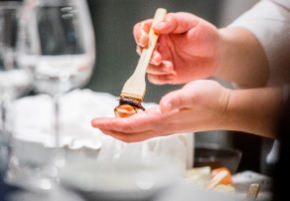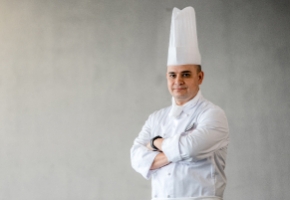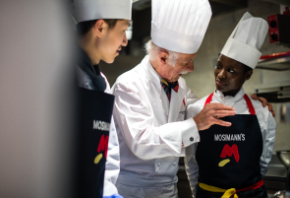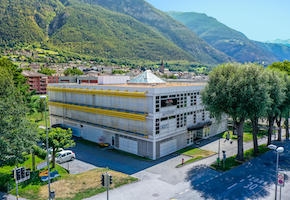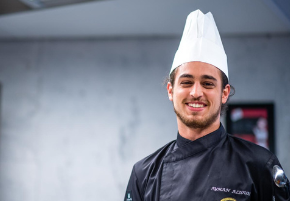- About
- Programs
- Campus Life
- Career Services
- Admissions
- News & Events
- Alumni
15 Essential Chef Skills for a Successful Career
Discover the 15 essential chef skills needed for a successful career in culinary arts. From knife work to leadership, learn what it takes to excel.
Key Takeaways
- Professional chef skills combine technical expertise, leadership, and business knowledge.
- Knife skills and heat control form the non-negotiable foundation of culinary craft.
- Organization and food safety are critical for kitchen operations and legal compliance.
- Leadership and communication skills separate good cooks from great chefs.
Cooking is often described as both an art and a science. Like any art, great cookery calls for creativity, a refined sense of taste, an eye for detail, and a respect for craft that gives ingredients new character. At the same time, it carries the precision of science, where principles and disciplined technique decide the outcome of a dish.
Chefs have to balance both sides. The standard they work toward combines consistent quality with the ability to perform under pressure. It includes guiding a team, setting the pace in the kitchen, maintaining focus on detail, and upholding excellence in every service. To reach that point, they need a foundation of chef skills that support both their creativity and their command of technique.
The 15 Essential Skills Every Chef Must Master
Great kitchens and chefs run on many kinds of know-how: cooking techniques at the stove, plating food, team leadership on the line, and safety systems that protect guests.
The following are among the most important skills every chef should develop in order to meet the demands of modern kitchens and evolving guest expectations.
Precision knife skills
Knife work is the constant in any professional kitchen. Very few dishes make it to the pass without a knife being involved at some point.
Proper knife skills are the non-negotiable foundation of a chef's craft. They affect how fast you work, how safely you move, and how evenly your ingredients cook.
That's why at Culinary Arts Academy Switzerland (CAAS), from the start, students are equipped with a full professional knife set, including a chef's knife, to have and to master. This investment is practical: they use it daily while training in state-of-the-art kitchens, learning real techniques under the guidance of experienced instructors.
Mastery of heat and cooking methods
Temperature often determines everything, from whether a chicken breast stays juicy to how sugar browns into caramel. The skill lies in knowing how and when to apply the right kind of heat.
Start Your Culinary Journey
Learn the art of cooking in a world-class environment
Braising requires patience and attention to liquid levels. Roasting needs an eye for even browning. Sautéing demands quick, confident movement over heat. These are all techniques aspiring chefs need to master through repetition and observation.
Rather than relying only on timers, CAAS students also learn to watch and listen. The hiss of a sear, the shine of butter as it foams, the slow collapse of onions as they caramelize; these signals become part of the learning process.
Flavor development and palate training
Sweetness, saltiness, sourness, bitterness, and umami are the five basic tastes that form the foundation of flavor. Understanding how these interact is fundamental to professional cooking.
A well-balanced dish builds in layers. Brightness from citrus can lift a heavy sauce. Bitterness can bring structure and clarity to a dish that leans too sweet. Each element supports the next, shifting the flavor with every bite.
Palate training involves consistent tasting and adjustment. At CAAS, students learn how to balance flavors and elevate even the most straightforward recipes. Exposure to global cuisines broadens their taste vocabulary and strengthens their ability to identify what a dish needs.
Organization and time management
The French concept of mise en place, meaning "everything in its place," is central to culinary efficiency. This preparation philosophy guarantees that all ingredients are prepped, tools are ready, and timing is planned before a dish even begins. Without it, service slows and quality suffers.
At CAAS, students practice mise en place in realistic kitchen environments. They manage prep lists, prioritize tasks under supervision, and learn how to adjust when things fall out of sync.
The skill of timing multiple components so they finish together is a mark of a professional. This kind of time management grows from structured practice and mentorship from chefs who model how to stay composed and organized during pressure.
Food safety and sanitation
Food safety is a legal and ethical responsibility in every professional kitchen. Compliance with safety regulations protects guests from illness, ensures operations meet health standards, and helps maintain the trust and reputation of the establishment.
Standard practices include keeping perishable items outside the danger zone (below 5°C or above 60°C), preventing cross-contamination between raw and cooked foods, and regularly sanitizing surfaces, equipment, and tools. These protocols are part of daily kitchen operations at every stage of food handling.
Unwavering attention to detail
Precision is what sets great cooking apart. Portion sizes, seasoning levels, plating alignment—these all define consistency, and consistency defines trust.
Chefs are trained to recognize subtle variations in color, texture, aroma, and shape. These checks allow them to deliver the same result plate after plate, even during busy service. Attention to detail also applies to inventory management, prep systems, and team training, where clear standards help maintain flow and prevent errors.
In a professional kitchen, this mindset becomes part of the routine. It supports quality, reinforces discipline, and builds trust between the team and the guest.
Plating and visual presentation
People experience food first with their eyes. A well-plated dish invites attention and frames the flavor experience. Successful presentation involves color contrast, texture variety, intentional use of negative space, and thoughtful height or layering.
At CAAS, students learn how to plate dishes that reflect both elegance and restraint. They understand portion control, how to position elements with precision, and how garnishes can enhance rather than overwhelm. The visual impression becomes a final step in telling the dish's story.
Sauce and stock making
Stocks and sauces form the base of many of the world's great dishes. A well-made stock brings depth and structure to soups, risottos, braises, and sauces.
Classic French mother sauces—béchamel, velouté, espagnole, tomato, and hollandaise—continue to serve as a framework for many variations used across global cuisines. Learning how to build these from scratch teaches control of flavor, texture, and balance.
Making stock requires patience and attention. Bones, vegetables, and aromatics are simmered slowly to extract depth and clarity. Reductions are monitored carefully to achieve the right consistency. These processes are quiet and technical, but they turn basic ingredients into something much more refined. Mastery of these techniques marks an important step in professional culinary training.
Baking and pastry fundamentals
Unlike cooking, where adjustments can be made during the process, baking requires exact measurements, controlled temperatures, and a clear understanding of how ingredients interact. Chefs must know how gluten forms structure, how leavening agents create rise, and how sugar, fat, and moisture affect texture and stability.
For those pursuing advanced skills in this area, our Swiss Diploma in Pastry Arts at CAAS offers a focused, one-year program in traditional and contemporary pastry and confectionery. Designed for aspiring pastry chefs and entrepreneurs, the diploma emphasizes hands-on training in Swiss and European dessert techniques by combining artistic presentation with deep technical knowledge.
Whether incorporated into broader culinary training, as in the Bachelor of Arts in Culinary Arts at CAAS, or studied as a dedicated focus, baking and pastry skills remain essential to a well-rounded chef's education.
Creativity and adaptability
No kitchen runs exactly as planned. Ingredient availability shifts. Customers request substitutions. Menus evolve with the seasons.
Chefs who thrive under these conditions think resourcefully. They adapt recipes without losing their vision, swap ingredients without compromising flavor, and solve problems while maintaining quality and presentation.
Developing this kind of creativity requires practice under pressure. One way students hone it is through structured challenges, such as the Mystery Box competition. In this exercise, participants are given a set of surprise ingredients—such as guinea fowl, red mullet, quinoa, morel mushrooms, almond powder, and strawberry purée—and tasked with creating a cohesive three-course menu. One ingredient, like rhubarb, may be required in every course, prepared in a different way each time.
These conditions reflect real-world demands: working with what's available, making bold choices on the fly, and adjusting to unexpected limitations. Exercises like these train chefs to remain agile and inventive—skills that prove essential in both daily service and long-term career growth.
Problem-solving under pressure
A kitchen during dinner service is a test of endurance and focus. Equipment breaks. Orders pile up. Timing issues escalate. In these moments, chefs must solve problems instantly, without letting stress affect the quality of what's leaving the pass.
As Hannah Corado, Pastry Chef de Partie at Hotel Adler in Germany and a graduate of CAAS, puts it:
Working in the kitchen is all about loving what you do, and having the ability to stand under pressure. If you are going to make the leap and start working in this area, make sure this is what you want. Be mentally prepared for long working days and learning how to deal with stress.
Her advice reflects the importance of knowing how to stay steady in the middle of chaos, while still delivering consistently. Problem-solving under pressure is about staying present, leading calmly, and keeping the operation moving forward.
Clear and calm communication
Communication keeps the kitchen aligned. In the brigade system, timing and accuracy rely on spoken signals that are brief, clear, and understood immediately. Even a small miscommunication about a table number or ingredient change can disrupt the entire flow of service.
Chefs use precise terminology, confirm instructions, and respond to issues without raising tension. A well-run kitchen depends on this rhythm. It allows orders to move forward, mistakes to be corrected quickly, and team members to stay on track.
Good communication is part of daily practice. It shows up in how chefs check on progress, give instructions, and stay connected with their team from prep to pass.
Leadership and team motivation
Leadership in the kitchen is measured by presence, not position. A strong chef leads through action—teaching new cooks, correcting mistakes respectfully, and maintaining professional standards through every service. When pressure builds, the tone set by leadership determines whether a team holds together or falls out of sync.
This kind of leadership isn't based on command. It grows through consistency, reliability, and quiet discipline. As Jet Lo, a Swiss Education Group graduate and head chef at Ding Dong in Singapore, explains:
People look up to you when you're willing to do the same menial tasks as everybody else. This is where the training I received with Swiss Education Group has helped me greatly. I learnt to be more confident in my work and the leadership skills I picked up in school are being put to use now as I lead my own team here in the restaurant.
Leadership is not about titles. It's about being steady, approachable, and accountable—qualities that shape team culture and inspire others to do their best work.
Business acumen
Behind every great restaurant is a chef who understands the numbers. Menu pricing, food costs, labor budgeting, and inventory control—these aren't side concerns. They keep the doors open.
CAAS students are trained in business fundamentals alongside culinary techniques. Students are placed in kitchens where they're exposed to the full picture: purchasing decisions, supplier relationships, daily revenue goals, and waste reduction strategies. These placements connect what's learned in theory to the real pressures of running a profitable operation.
As alumna Donya Modir shares:
The huge attention CAAS paid toward helping me complete and fulfill the internship… that was always at the top of the list of important objectives, not only for me, but for all the students. That is truly what shaped me into the person I am today.
That firsthand experience, paired with close mentorship, helps CAAS students develop their business acumen alongside their culinary skills.
Ingredient sourcing and knowledge
Great dishes start with quality ingredients. That means knowing what's in season, which suppliers offer consistent quality, and how growing practices affect taste and cost.
Chefs who work with the rhythm of nature rather than against it are more likely to create balanced, sustainable menus. Building strong relationships with farmers, producers, and suppliers also helps ensure consistency in both quality and supply.
Ingredient knowledge extends beyond just availability. It includes how soil, climate, and production methods influence taste and texture. With this foundation, chefs are better equipped to adapt to substitutions, reduce waste, and align their food philosophy with long-term sustainability goals.
The Recipe for a Lasting Career
A good cook might have a great palate. Another might have flawless knife work or an instinct for balancing flavors. But becoming a chef means more than excelling at one or two things. It's about bringing all the necessary skills together and continuing to refine them every day.
That mindset is what sets great chefs apart—and it's exactly what CAAS is designed to cultivate.
As Professor Yann Muriset puts it, "Our programs are so complete. We teach everything from kitchen work and baking to the business and economics side of the profession… We help students get a foot into the best establishments in the world."
Our students are given the tools to lead in the kitchen and the mindset to keep evolving long after they leave it. So, join our BA in Culinary Arts or the MA in Culinary Business Management. The focus is the same: professional training paired with real-world experience, personal discipline, and an openness to growth. You'll leave with the tools to lead a kitchen—and the mindset to never stop sharpening them.
Frequently Asked Questions
What are the 5 duties of a chef?
A chef's primary duties include menu planning, food preparation oversight, kitchen staff management, inventory control, and ensuring food safety compliance.
How do you elevate your cooking when you’ve already mastered the basics?
Focus on specialized techniques, develop signature flavors, pursue advanced certifications, and gain experience in diverse culinary environments through internships or staging opportunities.
Interested in studying at CAAS? Download our brochure to learn about our programs!


